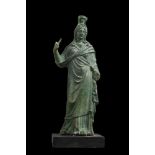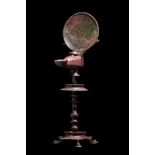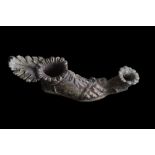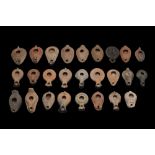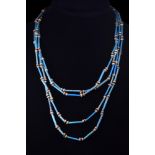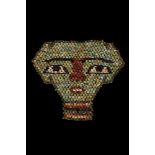Verfeinern Sie Ihre Suche
Schätzpreis
Kategorie
- Jewellery (92)
- Greek, Roman, Egyptian & Other Antiquities (85)
- Arms, Armour & Militaria (56)
- Sculpture (41)
- Ceramics (39)
- Coins (37)
- Chinese Works of Art (28)
- Glassware (25)
- Books & Periodicals (16)
- Salvage & Architectural Antiques (14)
- Porcelain (13)
- Collectables (9)
- Taxidermy & Natural History (6)
- Vintage Fashion (6)
- Classic Cars, Motorcycles & Automobilia (4)
- Furniture (4)
- Metalware (4)
- Textiles (4)
- Lighting (2)
- Islamic Works of Art (1)
- Musical Instruments & Memorabilia (1)
- Oil, Acrylic paintings & Mixed Media (1)
- Scientific Instruments (1)
- Stamps (1)
- Tools (1)
- Liste
- Galerie
Ein Abonnement der Preisliste ist notwendig um Ergebnisse, von Auktionen die vor einem längeren Zeitraum als 10 Tagen stattgefunden haben, ansehen zu können. Klicken Sie hier für mehr Informationen
Ca. Early 3rd century AD. An over life-sized portrait, gracefully sculpted, the Empress portrayed as a mature woman, her oval shaped face is smoot...
Ca. 200 AD. A finely carved in extremely high relief – virtually in the round – section of a marble sarcophagus depicting the god Eros (Roman Cupi...
Ca. 100-200 AD. A large marble cupid statue carved in the round. Cupid is depicted nude and fleshy, standing and motion to the right, with his rig...
Ca. 200-300 AD. A pair of beautiful, life-size marble statues of nude children representing Harpocrates, the god of silence and secrecy, each repr...
LARGE ROMAN MARBLE VENUS
Ca. 200-300 AD. A marble torso of goddess Venus (Greek Aphrodite) standing with her weight on her left leg, the right leg slightly bent and advanc...
2022.The Space Venus is a contemporary adaptation of the Large Roman Marble Venus (Lot. 63), created by Matthew Dorabiala a talented London-based ...
Ca. 100 AD. A bronze statuette of Jupiter depicting Zeus Brontaios, the Thunderer, modelled in the round after a statuette by Greek sculptor Leoch...
ROMAN BRONZE CERES STATUETTE
Ca. 100-300 AD. A very fine bronze statuette of Ceres (Greek Demeter), the goddess of agriculture and fertility, depicted standing and wearing a l...
Ca. 100-300 AD. An outstanding pair of bronze and iron fittings, each one comprising a spiral fluted column with an iron rod projecting from the I...
Ca. 100-300 AD. A pair of bronze chariot appliqués, each with a bust formed separately and mounted at the centre, each comprising a discoid body w...
Ca. 200-300 AD. A charming cast-bronze statuette of a bear standing on its two slender back legs and holding a round and shallow container to be f...
Ca. 200 AD. A cast bronze decorative tripod stand with an oil lamp. The feet are rounded, abstract forms that suggest the paws of an animal; a hea...
Ca. 400-500 AD. A Late Roman bronze jug rising from a flared short foot. The vessel features an inverted piriform lower body with ribbing features...
Ca. 300-400 AD. A bronze jug with a flaring step rim, restricted neck, piriform body, and a long figural handle with a plate in the form of a head...
Ca. 200 AD. A silver kylix with a hemispherical bowl resting on a concave foot and two equally spaced loop handles. Decorated on the exterior with...
Ca. 100-200 AD. A beautiful cast-bronze oil lamp in the shape of a right foot wearing a sandal. The lamp has two openings, each finely detailed wi...
Ca. 300 BC - 400 AD. A large group of terracotta oil lamps of various types, including Greek, Roman, Islamic and Byzantine. The collection comes w...
Ca. 100-300 AD. A redware mortarium with a flanged rim and a conical shape. It tapers to a flat base. The interior has incised pattern of radiatin...
HUGE ROMAN GLASS PLATE
Ca. 50-300 AD. A stunning glass plate in a greenish-blue fabric with an outward folded rim, hemispherical bowl and applied ring foot. Two dolphin-...
Ca. 100-300 AD. A rare, yellow-green coloured glass dish with a folded broad rim. The interior surface is plain whilst the outside is decorated wi...
ANCIENT ROMAN GLASS JUG
Ca. 200-300 AD. An elegant Ancient Roman blown light green glass jug, featuring an elongated pyriform body leading to a long cylindrical neck and ...
Ca. 200–300 AD. A blue-green, free-blown glass jug featuring a broad ovoid body with a long cylindrical neck, an applied trail low on the neck and...
ROMAN GLASS JUG
Ca. 300 AD. A beautiful light blue jug with a globular body resting on a low ring foot, a cylindrical neck featuring a deep blue tooling, an outsp...
ROMAN GLASS JUG
Ca. 200-300 AD. A one-handled jug in a translucent green palette with a conical body, a tall, tapering cylindrical neck, and strap handle with thu...
Ca. 100-200 AD. A beautiful blown flask with an ovoid-shaped body, funnel-shaped neck with ribbed horizontal decoration, and two vertical trailed ...
ROMAN GLASS JAR WITH HANDLES
Ca. 300 AD. Translucent green; handles in the same color. Outsplayed rim, folded over and in, and smoothed into the side of mouth; broad funnel-sh...
Ca. 100-300 AD. A rock crystal intaglio bearing an engraved gryllos motif, comprising a bust of left-facing Minerva wearing a plumed helmet, and t...
Ca. 300 AD. A gold finger ring with a D-shaped hoop and a slightly raised, rectangular bezel bearing the inscription "FIDEM" ("Loyalty"). It is th...
Ca. 100-200 AD. A rare gold ring with a circular hoop featuring an elliptical deep green jasper intaglio setting. The intaglio depicts the myth of...
Ca. 100-300 AD. An amazing gold ring comprising a slender hoop with elaborately decorated shoulders and raised bezel with banded agate intaglio de...
Ca. 100-300 AD. A gold finger ring composed of a tapering hoop with faceted shoulders supporting an amethyst intaglio engraved with a dynamic scen...
Ca. 100-200 AD. An oval rock crystal intaglio depicting a right-facing female bust, flanked by quiver and arrows. The latter led to identifying th...
Ca. 200 AD. A red gem intaglio bearing an engraved bust of Sol Invictus wearing a radiate crown set in a possibly later gold ring with tapering ho...
Ca. 100-200 AD. A gold ring with a circular band, flared shoulders, and an oval bezel set with a carnelian gem depicting a scorpion. The ring is i...
Ca. 1-100 AD. A finely rendered pair of gold earrings, each formed from a twisted wire hoop, which tapers towards one end and on the other display...
Ca. 2nd century AD. A large sardonyx cameo with a finely carved depiction of a bust of Faustina II set in a gold pendant or brooch setting. She is...
New Kingdom period, Ca. 1292 -1077 BC, 19th - 20th Dynasty, Ramesside Period. A mummiform ushabti formed of painted pottery is wearing a bipartite...
Late Dynastic Period, Ca. 664-332 BC. A pale turquoise faience Egyptian ushabti modelled with a tripartite wig and false beard. His arms are cross...
Ca. 664-525 BC. An ancient Egyptian funerary statuette with a mummy shaped body and back pillar standing on a small base plate. Modelled details, ...
Late Dynastic Period, Ca. 664-332 BC. A mummiform figure in the form of an ushabti, moulded in a light-blue, glazed faience, wearing a tripartite ...
Early Third Intermediate Period, Ca.1070-945 BC. A mummiform ushabti wearing a pain tripartite wig and a divine beard. The front lappets of the wi...
ANCIENT EGYPTIAN FAIENCE USHABTI
Late Dynastic Period, Ca. 664-332 BC. An ancient Egyptian blue faience ushabti. The mummiform figurine wears a tripartite wig, his crossed hands h...
EGYPTIAN FAIENCE USHABTI
Ptolemaic Period, Ca. 323 BC. An ancient Egyptian faience mummiform ushabti wearing a plain tripartite wig and plaited divine beard. The wig is wo...
EARLY EGYPTIAN MARBLE VESSEL
Thinite Period, 1st-2nd Dynasty, Ca. 3100-2700 BC. An early marble vessel in piriform amphora-like shape which widens towards the neck with two ce...
Late Period, Ca. 664-332 BC. A long necklace string made of tubular and spherical faience beads arranged in a symmetrical manner. Restrung on a mo...
Late Period / Ptolemaic, Ca. 712-30 BC. A beautiful restrung necklace with tubular and discoid beads as well as a beautiful scarab. Scarabs were a...
Late Period / Ptolemaic Dynasty, Ca. 664-30 BC. A necklace made of restrung glazed beads with a faience amulet as its pendant. The beads are a ran...
EGYPTIAN AMULET OF BES
Late Period, Ca. 663-323 BC. Blue glazed faience amulet of the dwarf god Bes. Plumed headdress containing a suspension hole, a gnarling, somewhat-...
EGYPTIAN BEADED FUNERARY MASK
Late Period, Ca. 663-323 BC. An ancient Egyptian mummy shroud of beadwork from the chest of a mummified person, consisting of a net of dark green ...
Late Period, Ca. 664-332 BC. An ancient Egyptian mummy shroud of beadwork from the chest of a mummified person, consisting of a net of dark green ...
Late Dynastic / Ptolemaic Egyptian, Ca. 664-343 BC . A beaded mummy mask made of delicate faience beads in green, white, yellow, black, and red. T...
Late Period, Ca. 663-323 BC. An ancient Egyptian face mask formed of faience beads. Composed of turquoise, cream, black and red faience glazed com...
Ca. 600-500 BC. A terracotta protome depicting a lovely visage of a goddess with well-modeled facial features wearing a decorative headdress. A pr...
ETRUSCAN VOTIVE POTTERY FOOT
Ca. 700-500 BC. A salmon color pottery votive foot, depicted with simplified toes. Overall scattered mineral deposits and areas of surface encrust...
Ca. 300-1 BC. A substantial ceramic bull's head from a rhyton with naturalistic features; modelled with short horns, ears, frowning face, eyes, sn...
GREEK CYCLADIC ALABASTER JAR
Early Cycladic, Ca. 3000-2800 BC. A carved, bulbous jar having a rounded collar rim and four, carved equidistant small, perforated lugs around the...
Ca. 700-600 BC. A pottery vessel formed in brown, black, and red with incised decoration, the ovoid body with linear bands and rays emerging from ...
Ca. 700-600 BC. An Etruscan bucchero oinochoe in magnificent form with a bulbous base adorned with a register of incised linear lines, sitting on ...
Apulian, Ca. 350-300 BC. A rare red-figure kantharos. This tall stemmed cup has two sweeping high handles and a gently flared body that sits on a ...
Ca. 400-300 BC. A ceramic askos of an elegant form, this ancient vessel used to pour small quantities of precious liquids such as oil, possessing ...









